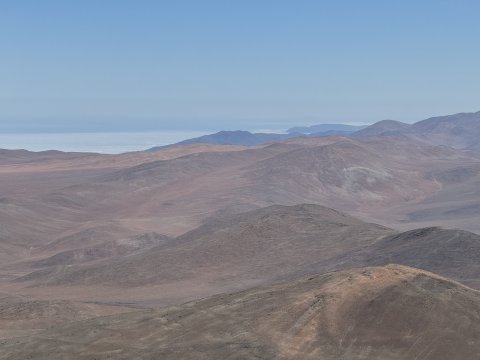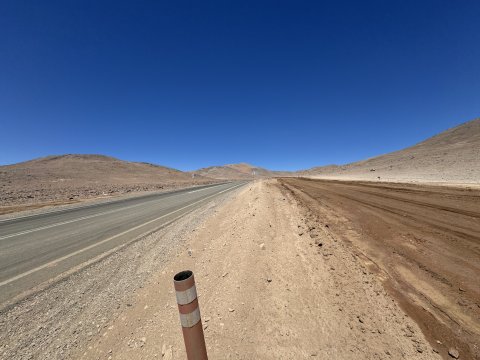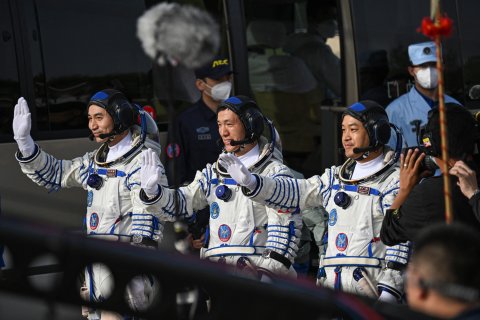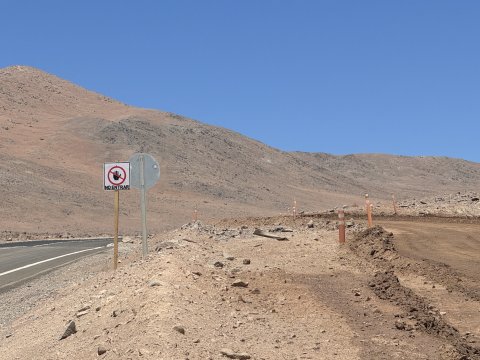
By Didi Kirsten Tatlow
China’s ambition to be the world’s greatest space power is taking it to the Moon, to other planets—and to the sepia dust of Chile’s Atacama Desert.
Here, in a lunar-looking landscape in the South American country, diggers are smoothing a rocky plain beneath an 8,600-foot Andean peak for a new astronomical observatory where Chinese scientists will monitor objects orbiting Earth and seek new stars—and where they could also conduct research that helps China’s fast-growing military space program under an agreement that leaves Chilean counterparts largely in the dark.
Newsweek has tracked China’s rapid expansion as a global power, from a verdant Caribbean island where it is building a foothold on America’s doorstep to the icy Arctic North where its growing presence is a challenge to the United States and NATO allies. There’s a network of ports that are civilian and military logistical bases around the world and hundreds of organizations with Communist Party links that are as embedded in the heart of America as in tiny Pacific islands. And now to this remote spot in the world’s driest desert.
The observatory will be just one of Beijing’s jumping off points for its goal of taking a leap into space and ensuring that it dominates in the heavens as well as the earth, part of its stated aim of becoming the preeminent power by the middle of the century and remaking the international order to its own design.
The ‘Anaconda’ Strategy
The push is part of what self-ruled Taiwan’s armed forces call an “anaconda strategy” of encirclement by China – ratcheting up pressure step by step in the way that the snake constricts its prey—except now on a global scale. China’s overseas presence has been growing for decades, yet the extent of its reach into every corner of the globe through infrastructure, trade, technology and research is becoming ever clearer with the rise of an apparatus in which its defense, scientific and business establishments are working together for the benefit of the Communist Party. Gaining an edge in space over rivals such as the United States will give Beijing a decisive ability to influence events wherever and whenever it chooses, as space – as well as being about planets and stars and galaxies – is about the satellites that enable activity on the ground, from mobile phones to banking to missiles that target via distant remote sensors.
Communist Party chief Xi Jinping has outlined a vision for global dominance by 2049, the 100th anniversary of the Communist revolution. It includes space and requires global observatories such as the one at Cerro Ventarrones. China has more space infrastructure in the region (including Antarctica) than anywhere else outside of China, according to Newsweek research. The United States once declared any intervention in the Americas by a foreign power was a hostile act.
“What we’re seeing in Chile is textbook Chinese strategy. Establish seemingly benign scientific facilities that can serve multiple strategic purposes. These observatories don’t just track stars—they can monitor satellites, gather intelligence, and support military space operations,” said Liza Tobin, a former China Director at the U.S. National Security Council.
“Beijing deliberately obscures these military applications behind a veneer of civilian research and international scientific cooperation, even keeping their own research partners in the dark about the true scope of their activities. And crucially, they’re positioned in locations that could help China counter U.S. advantages in space,” said Tobin, now a Senior Director for Economy at the Washington, D.C.-based Special Competitive Studies Project.

Purpose of the Project
China denies any hidden intent. Contacted via email, Jiasheng Huang, Acting Director of the Santiago, Chile-based Chinese Academy of Sciences South America Center for Astronomy, which is closely involved in the new observatory, said, “the project will be open for participation by the global scientific community.”
But U.S. forces are not convinced by assurances of innocent intent that echo others from China over its expanding presence from the Middle East to the Himalayas to artificial islands it has built in the South China Sea.
“The agencies and organizations operating these sites are extensions of China’s military arm. We are therefore concerned that Chinese-sponsored sites have been placed into countries in the Western Hemisphere for non-scientific purposes,” a spokesperson for the Defense Department’s Southern Command told Newsweek. Those concerns include monitoring and possibly disrupting U.S. and allies’ communications.
Two Western intelligence sources with direct knowledge of the agreements between the Chinese state institute and its Chilean partner at the Ventarrones Observatory, including one signed in April, said the Chinese could potentially deploy special security measures that could exclude the Chileans from part of the site that is being built and paid for by the Chinese state.
China’s Push for Supremacy in Space
Research there could support China’s “space situational awareness” – a vital component of military action – perhaps even help its budding hypersonic weapons programs to target the U.S. homeland from the southern hemisphere. Chinese scientists intend to monitor continuously specific locations in space for purposes that are unclear.
The future observatory is rising in a land concession of the Chilean government to a private university in the Pacific Ocean city of Antofagasta, Christian Moni Bidin, an astronomer leading the project on the Chilean side, told Newsweek. The city is the center of the mining region and about 55 miles away by road.
Moni Bidin told Newsweek that China’s research goals were unclear, that they didn’t know yet what instruments the Chinese scientists were planning to install or how many people would be there, and that the plans presented so far were likely just a first step toward bigger activities.

A Chinese state science plan, the Sitian Project, seen by Newsweek, identifies the Ventarrones Observatory as one of five overseas nodes in a global surveillance system to “fully scan” across the entire Southern and Northern Hemisphere skies every half an hour to “meet national strategic needs.”
China makes no secret of the link between its space interests and security goals. “Explore the vast universe, become a great power in space!” Xi has told scientists and the military. China’s national defense strategy says it will “safeguard China’s security interests in outer space, electromagnetic space and cyberspace”, and the government says it will create “effective governance in space.”
To the Moon – and Beyond
China’s plans include settling and mining the Moon and getting to Mars and Jupiter, as well as guarding the world from asteroids, growing amounts of man-made space junk, and monitoring for supernova explosions and gamma ray bursts. In June, the Chang’e-6 probe brought rocks from the far side of the Moon—a world first. The U.S. shares many of these goals and has more satellites in space than China, as well as a large military space program.
But the Communist Party is catching up fast, launching about 200 satellites of all kinds each year. In August it sent into orbit the first small communication satellites of its “Thousand Sails” project that aims to outdo Starlink, the satellite constellation of billionaire Elon Musk. Together with another, more hidden, project called “Guowang” (State Net), Beijing aims to place at least 25,000 small satellites in orbit. Starlink currently has about 6,700 with plans for 42,000.
According to China’s Space White Paper published in 2022, Ministry of State Security policies and scientific and military plans, Beijing will develop a “space surroundings governance system” by 2027. It is setting up institutions including a China-run headquarters and a bureaucracy to research, settle and mine the Moon—the International Lunar Research Station (ILRS)—with Russia. Its Asia-Pacific Space Cooperation Organization (APSCO), headquartered in Beijing, is drawing up a body of “space law”.

Responding to the challenge, in 2019, then U.S. President Donald Trump—now president-elect—set up America’s newest military branch, the Space Force. Its members are called Guardians and wear deep blue uniforms to represent the vastness of space.
A top Space Force officer told Newsweek he believed China’s People’s Liberation Army (PLA) was focusing on space to prepare for conflict and that it had made rapid advances over the past five to six years. It was already at a point where it put U.S. forces and their allies at risk in the event of conflict in East Asia—such as over Taiwan, which China claims as its own.
“They have the ability to hold at risk our satellites in outer space at every orbital regime,” said Maj.-Gen. Gregory J. Gagnon, the Deputy Chief of Space Operations for Intelligence. “But they also want to engage the United States and the coalition forces far away from the shorelines of China. In order to do so, they have undertaken the most rapid advancement of space capabilities that I have ever seen, since President Xi came to power.”
“U.S. forces and coalition forces in the western Pacific are now under constant surveillance from the PLA aerospace force from outer space,” Gagnon said, adding that it gave them the ability to hit targets with missiles from great distances.
China rejects accusations that its goals in space are for military purposes.
“The Chinese side advocates the peaceful use of space, opposes the weaponization of and arms race in space, and promotes the building of a community with a shared future for mankind in the field of space,” Ministry of Defense spokesperson Senior Colonel Zhang Xiaogang said in November in Beijing.
“The United States considers space a ‘war-fighting domain’ and is enhancing its space forces, establishing military alliances, and militarizing space. These acts pose grave threats to the shared security and development interests in the space of all countries,” Zhang said. “Facts have proven that the United States is the greatest threat to space security and the biggest instigator of the space arms race.”
Playground for Astronomers
Chile is one of the most coveted locations for space observation on Earth with its clear skies, dry conditions and high altitudes. The United States, European countries, and Japan also have facilities here. Up to 70 percent of the world’s large telescopes are in Chile.
The 10 square-mile Ventarrones Astronomical Park, in bare hills off a dusty highway, is a joint project of the Universidad Católica del Norte (UCN) and China’s National Astronomic Observatory of the Chinese Academy of Sciences (NAOC). China is initially investing $80 million in building and equipping the site that will have about 100 telescopes. The company in charge is a Chilean wholly owned subsidiary of the China State Engineering Construction Corporation, which is active in military construction.

“Chile is very important for China’s future space activities,” Zhu Lei, an astronomer at the China Academy of Sciences, told Newsweek in Santiago. As well as being excellent for observing space, its arid rocky terrain and mining knowledge will also help with China’s Moon construction and exploitation plans, he said.
Reaching agreement took eight years of negotiations that were “long and hard” and “somewhat strange,” according to Moni Bidin, UCN’s park director. He told Newsweek in Chile that a key question had been over proposed Chinese restrictions to the land.
“It’s reasonable that the Chinese said, OK, I build it. It’s mine. I decide,” Moni Bidin said. “But to the government I cannot say, this is Chinese space, and I cannot get in.”
The standoff was resolved when the university told the Chinese that they did not intend to use the infrastructure but that they could not be shut out. “I don’t mean to come and use your bed or use your computer or whatever,” Moni Bidin said. “It’s just that if we knock on the door, you have to open.”
Some elements remained unclear, Moni Bidin said—such as what instruments the Chinese would use, how many people it would bring, and who. While the agreements did not explicitly rule out any research that could have military applications, “we say to all parties, even to the Chinese, we do not want classified activities or classified data,” said Moni Bidin. The university mostly wanted to train students at the site and hold educational exchanges with China, he said.
But three intelligence sources who spoke to Newsweek on condition of anonymity questioned whether the university would know what was going on, let alone be able to do anything about it. The site in Chile will eventually be fully autonomous, with its own power source, dormitory, warehouse and administrative buildings.
The agreement meant the Ventarrones Observatory would include a “concession within the concession” said another scientist in Chile who is close to the project, granted anonymity to discuss sensitive matters. A special security fence could surround about one square kilometer (0.4 square miles), an intelligence source said.
In most space cooperations in Chile that are built and paid for by overseas observatories or governments, the local partner gets 10 percent of observation time. But the university said it would only get two nights a month at Ventarrones. Based on the agreements, the intelligence sources said it was in fact only one night and that even this could fall away if the Chinese scientists had “important NAOC scientific projects” that required “continuous monitoring.” The Chinese would own all the buildings, infrastructure, telescopes and sensors, the main access road leading up to the site, and the data collected, they said.

Asked to comment on the university’s goals, if it was aware of concerns the site could be used as a dual-use space enabling facility, and if it could confirm details of the agreement with the Chinese scientists, Karol Trautmann Thomas, Director of International Relations at UCN, said: “After careful consideration, we regret to inform you that we are unable to provide information or comments regarding your queries at this time.”
Moni Bidin said that the contract was private. The Chinese embassy in Santigo did not respond to Newsweek requests for comment. Chile’s Ministry of Science did not respond to emailed requests for comment.
“As the project is processing in its early stages, the updated information will be released according to the project progress on the official website,” Jiasheng Huang, the spokesperson and astronomer with the China Academy of Sciences told Newsweek via email.
The NAOC website shows only two articles—one from 2016 describes Xi’s visit to Santiago where the Chinese leader and Chilean then-President Michelle Bachelet witnessed the signing of a MOU for an “observational base”. Another article from 2017 has been removed.

Excluded?
The terms China sought in Chile echo the secrecy at a similar observatory across the border—the deep space Espacio Lejano Station in Argentina’s Neuquén province in Patagonia.
Also built by a Chinese state-owned company, the agreement states that the PLA’s China Satellite Launch and Tracking Control General (CLTC) operates the site which provides ground support for its space operations and promises that the government of Argentina will not “interfere or interrupt normal activities” nor “significantly affect” operations. Chinese, not Argentine, labor law applies to Chinese citizens there, it says.
“It is important to note that if a Chinese entity, whether it’s scientific or academic, is preventing entry from a host nation. That should be concerning, because that’s not sovereign Chinese space, that is not an embassy,” Space Force’s Gagnon told Newsweek.
Ventarrones Observatory will be at least the 16th element of China’s critical infrastructure in Latin America that enables its space activities, according to Newsweek research. More may come: the Sitian Project identifies a Mexican observatory as a future part of its global “Sky Monitoring” network. Panama recently signed an MOU to join the China-Russia moon station and to engage in deep space exploration with China. Meanwhile, Brazil agreed in November to expand space cooperation with China and join its Thousand Sails program. They already collaborate on satellite launches.
Latin America is not the only focus of intense Chinese space interest.
In the United States itself, there is a long-term research collaboration between the Massachusetts Institute of Technology’s Haystack Observatory in New England and the Chinese Meridian Project which supports China’s space “situational awareness,” research projects seen by Newsweek show. Meridian is operated by the China Academy of Science’s National Space Science Center. Haystack and Meridian have dual affiliated staff.
“It’s all fun and games until we are at war and the PRC has access to our mainland U.S. taxpayer funded radars,” said LJ Eads, the founder of the research analytics website Data Abyss, which is co-funded by the Pentagon.
In Europe, China has worked in Nordic countries that are NATO allies on a cutting-edge radar that scans the upper atmosphere, called EISCAT-3D.
One place where collaborations are happening is in Norway’s Svalbard Archipelago in the Arctic, where polar bear tracks mark the ice that keeps it locked in for much of the year.
A Newsweek investigation there revealed that a Chinese scientific institute that is operating on the island where “war-like purposes” are forbidden is part of China’s defense establishment, raising questions over whether the innocuously named China Research Institute of Radio Wave Propagation is defying the ban with its potential dual-use research for its parent, the China Electronics and Technology Group Corporation (CETC), China’s biggest military electronics conglomerate.
Newsweek also found that at least one Chinese aerospace defense contractor is being served by a satellite ground station on Svalbard, even though Norway forbids data transmission “only or mainly” for military purposes.
China says its research goals in the Arctic are peaceful and for the good of all humanity. But its expanding presence there concerns the U.S. and is stirring unease in NATO.
“Chinese scientific interests and projects in the Arctic are likely to be used for strategic and military progress. It’s understood that this information will be transmitted to the Chinese military. That’s simply the nature of the Chinese government,” said Marc Lanteigne, a Canadian professor of political science at The Arctic University of Norway in Tromsø.

For sure, China is not the only country with a global network of infrastructure to enable its activities in space.
“The U.S. and its allies absolutely have space nodes around the globe,” said Gregory Falco, an aerospace professor at Cornell University. “The difference though is that the U.S. does not cloak its activity as science and deceive its host countries.”
Dependency
Space cooperation with China is attractive for many countries in Latin America whose economic dependence on China is rising.
From cherries to copper, about 40 percent of Chilean exports go to China. About 60 percent of its electrical grid is owned by Chinese companies. In another example of growing clout Xi recently inaugurated a major port in Chancay in Peru that will be owned and operated by Chinese state shipping behemoth COSCO.
China is also building up its presence in the Caribbean, right on the doorstep of the United States.
On the paradise island of Antigua, a mangrove forest and a marine reserve are making way for a new Chinese-run special economic zone. According to documents reviewed by Newsweek, the zone will have its own customs and immigration formalities, a shipping port and a dedicated airline, and will issue passports.

Antigua has benefited from hundreds of millions of dollars in Chinese loans and the relationship is so close that officials there have been told to study Xi Jinping Thought.
Western countries were simply not giving Antigua the help it needed, Antiguan Prime Minister Gaston Browne told Newsweek in an interview. “I see China, though, as a country that stands on truth, and a country that, you know, at least has some level of empathy for small states, and generally for poor and dispossessed persons globally.”
Browne’s office rejected any suggestion that there was anything sinister about the relationship with China and said it was also friends with the United States, but the report of the extent of the Chinese plans revealed by Newsweek jolted some in Washington.
“The alarm bells are ringing over China’s increased presence in our hemisphere,” Rep. Mike Waltz (R-FL) told Newsweek by email in May. He is now Trump’s national security adviser.
That increased presence is set to grow further in Chile and elsewhere.
There was a “delicate dynamic” that the Chilean government had to manage given that Chile is close to the U.S. but also has a free trade agreement with China, said Francisco Urdinez, a professor at the Pontificia Universidad Católica de Chile and the director of “Impacts of China in LAC” project.
“This dual dependency on both global powers places Chile in a particularly vulnerable position,” Urdinez said.
Then in August, the Universidad Católica del Norte in Antofagasta signed another agreement with a Chinese institution that works with the Chinese military. The agreement with the Deep Space Exploration Laboratory of the China National Space Agency (CNSA) echoes the goals of Espacio Lejano Station in Argentina.
U.S. forces are watching closely, concerned.
“Monitoring space can help adjust for anomalies, avoid collisions, and call out nefarious behavior. To these ends, space data should be shared among partner nations. We have seen that even when asked by the host country, the PRC declines to share, or shares only very limited data,” the Southern Command spokesperson said.
“The PRC also uses these sites to steal or corrupt data and create more undue influence in the Western Hemisphere.”
____________________________________________________________
Didi Kirsten Tatlow is a Senior Reporter for International Affairs at Newsweek, based in Berlin. She reports on China and its interactions with the world as it seeks to rise to global preeminence with a focus on security, technology, politics and ideology, and international relations. A graduate of SOAS at the University of London, she can be reached at d.kirstentatlow@newsweek.com X: @dktatlow. Energiesnet.com does not necessarily share these views.
Editor’s Note: This article was originally published by Newsweek, on December 18, 2024. EnergiesNet.com do not reflect either for or against the opinion expressed in the comment as an endorsement of Petroleumworld or EnergiesNet.com
China’s Newest Project Could Increase Military Presence in Outer Space – Newsweek
Use Notice: This site contains copyrighted material the use of which has not always been specifically authorized by the copyright owner. We are making such material available in our efforts to advance understanding of issues of environmental and humanitarian significance. We believe this constitutes a ‘fair use’ of any such copyrighted material as provided for in section 107 of the US Copyright Law. In accordance with Title 17 U.S.C. Section 107. For more information go to: http://www.law.cornell.edu/uscode/17/107.shtml.
EnergiesNet.com 01 12 2025












